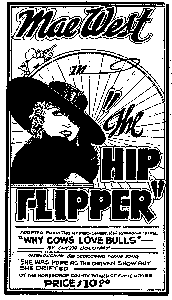The Kind Men Like
A new collection preserves the arcane art of the Tijuana Bibles
IN ALAN MOORE'S metacomic, The Watchmen, superhero Sally Jupiter had once upon a time been caricatured in a pornographic comic book. Years later, as an old broad with not many secrets left, Jupiter even kept a copy of the eight-pager as a souvenir of her youth. She wasn't the only collector, apparently. The cheaply printed, cheaply drawn underground comics--called "blue books," "jo-jo books" or, most frequently, "Tijuana Bibles"--are back to pollute new minds.
Tijuana Bibles (edited by Bob Adelman; $24; Simon & Schuster Editions) reprints dozens of these hard-core comics, most of which came from the collection of a woman named Madeline Kripke. In his introduction, cartoonist Art Spiegelman (who won the Pulitzer Prize for Maus) estimates that some 700 to 1,000 different "bibles" were made during the first half of our century. This is the most thorough reprinting yet of the anonymous adults-only cartoon pamphlets that were, as the name suggests, often printed and sold on the other side of the border.
The booklets reproduced here (most of the selections are from the 1930s) star dozens of obscure cartoon characters and movie stars, as well as more well-known figures, such as Blondie and Dagwood, Mahatma Gandhi and Adolph Hitler. The caricatures range from pretty good likenesses to the ugly scrawls you'd expect from a nasty little boy. Over the decades, various underground publishers have made facsimile editions of these pamphlets, but there has never been a collection as complete as Tijuana Bibles--and certainly never any edition issued with the imprimatur of a mainstream publisher.
I HAVE MIXED emotions about the outing of this inside joke. It is a risky proposition for Simon & Schuster, and the company deserves congratulations for taking risks. At the same time, it's dismaying to see how dated, how peripheral to the history of the genre, these little comics are. After years of tell-all movie-star biographies, images of movie stars bonking anonymous women don't carry any shock value. After you've watched the notoriously promiscuous Warren Beatty starring in a movie as Dick Tracy, a cartoon of Dick Tracy having sex somehow loses its flavor.
Younger readers will be even more apathetic. They'll ask, who are these people? Adelman tries to explain, in a few paragraphs beneath each reprinted page, the back stories of forgotten movie stars and cartoon characters. But he never gives enough information. Underneath "Boys Will Be Girls," depicting a gay gang bang starring James Cagney, Adelman neglects to identify the other participants--Cagney's Warner Bros. co-stars Pat O'Brien and Dick Powell--nor does he explain that the much-better-drawn "Gerta Gabbo" (Greta Garbo) is getting it on with her director, Rouben Mamoulian.
(All mere movie trivia, I realize, but I'm still wounded after talking to a college class last week in which only one of about 25 students could identify one of the stars caricatured here, Cary Grant. "They know who Jim Carrey is, anyway," a different instructor at the same school told me later.)
Simon & Schuster's lawyers must have come to some sort of legal arrangement with the Disney company. Seeing Donald Duck mounting Minnie in one of the comics (c. 1933) is especially bittersweet because of the Mickey Mouse Meets the Air Pirates Funnies case some 25 years ago.
A group of four artists (including Bay Guardian cartoonist Dan O'Neill) was sued for $700,000 by Disney for "unfair competition" because of their clearly satirical drawings of Mickey and Minnie in flagrante delicto, surrounded by a halo of flying "plutes" (cartoon sweat drops, that is). Decades later, the younger, wiser Disney has learned to incorporate the sexual elements that the older, family-oriented Disney supposedly left out. Consider, for instance, the mild innuendo in the last Mickey/Minnie cartoon short film I saw, "Runaway Brain."
That's the theory, anyway; you can compare the sexiness of the new Disney's Esmeralda in The Hunchback of Notre Dame to the half-clad Tinkerbell of the old Disney's Peter Pan. And now Disney, threatened by boycotts from fundamentalist Christians, has become, in one ironic sense, the enemy of repression.
Tijuana Bibles were, as Spiegelman writes, "a populist way to rebel against news media and advertising designed to titillate and manipulate, but never satisfy." Granted. And Tijuana Bibles, the book, is a secret museum of long-gone sexual and racial attitudes, a sort of Pompeiian wall upon which is scrawled the graffiti of the past. But the book has little intrinsic interest except for historians. A changing world has made these once-forbidden treats irrelevant to anyone they don't repel--they've become nothing but weird antiques for the collectors of the arcane.
[ Metro | Metroactive Central | Archives ]
Copyright © Metro Publishing Inc. Maintained by Boulevards New Media.

The Ultimate Mae West Movie: Even racier than her movies was the Tijuana Bible 'The Hip Flipper,' starring the comic-book version of Mae West.
From the Nov. 6-12, 1997 issue of Metro.
![[Metroactive Books]](/books/gifs/books468.gif)